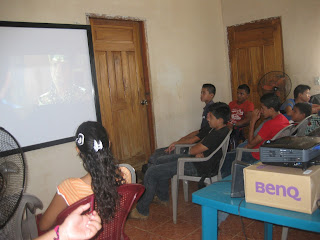Last week were two days to celebrate the students. Tuesday we
showed movies with a projector I brought back with me from Canada. You can get
them here but they are much more expensive. It worked nicely projected on to
one of our white boards.
Friday was a school dance. With so many students, we are going to have to move special events to another location. Insignificant issues like edible plants are easily forgotten in the excitement of the party. The students put in a few lempiras each and had the normal, anti-nutritional snack fare. I see that, thanks to the rains, most of the plants have recovered from the traffic.
We continue to measure land for our next housing project. We have, finally, established the majority of the boundary points. Four more points on one plot and it will be done. Very little official marking of boundaries has been done with a GPS. The person formerly in charge of the land office was more inclined to make up maps and give them to folks for a small consideration. Then he would, conveniently forget to input them into the office computer. This, of course, leads to difficulties when it is time to establish boundaries. We met one of our "neighbours" and are now using his map (from three years ago) as a starting point. Consequently, the need to measure again. Edgar and I were the ones able to read the maps and help the two men from the land office figure out which points went where. Sigh.
Monday, Edgar told me that he had taken a bag of Pigeon Pea seeds and planted them on his property. Hurrah. He planted over 100 seeds. it is an exciting first step in making his land productive year round with vertical sources of nutrition. He has, as well, ordered Willow cuttings to plant along the stream that bounds one side of the property. This week, as well, he gave two, standard shaped hoes a try. He found that they were faster and less painful to use than the traditional digging hoe or grub hook. He is quite excited about trying two others that we bought yesterday.
A hoe which can be used while standing upright is a great
improvement. It means, as well, that the maize can be weeded earlier and more
often which results in better production. Often, the tedious, painful way of
weeding means that the weeds are often over a foot high before being tackled.
By that time they have done serious damage to production. I need to find a
Dutch hoe yet to see how it performs.
The fish are still alive and, yesterday, Edgar divided them
into three tanks. We designed a small aerator using 3 toilet plungers. It seems
to work quite nicely.
Another art project - a sign for Chipilin - the girl is quite
pleased and so am I to see a plant being labelled so nicely.
TTYL
BB
















